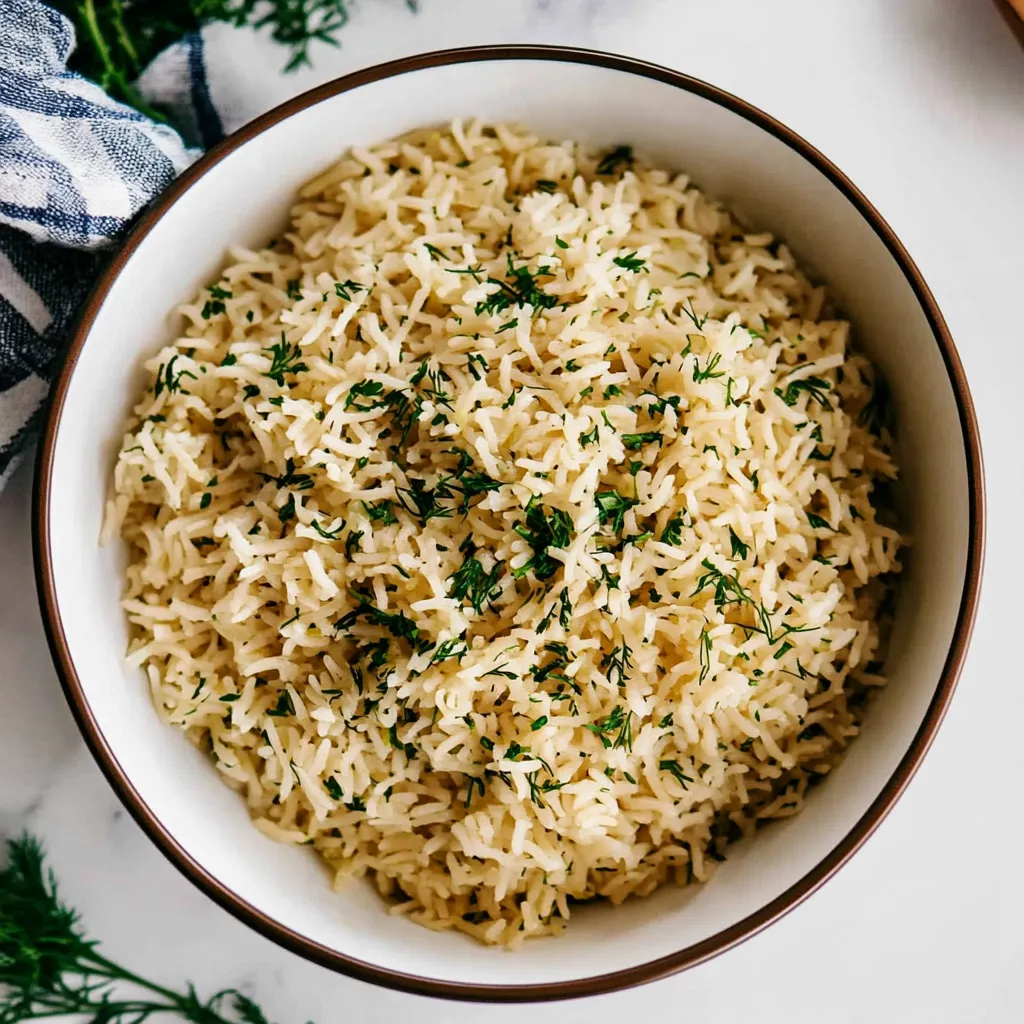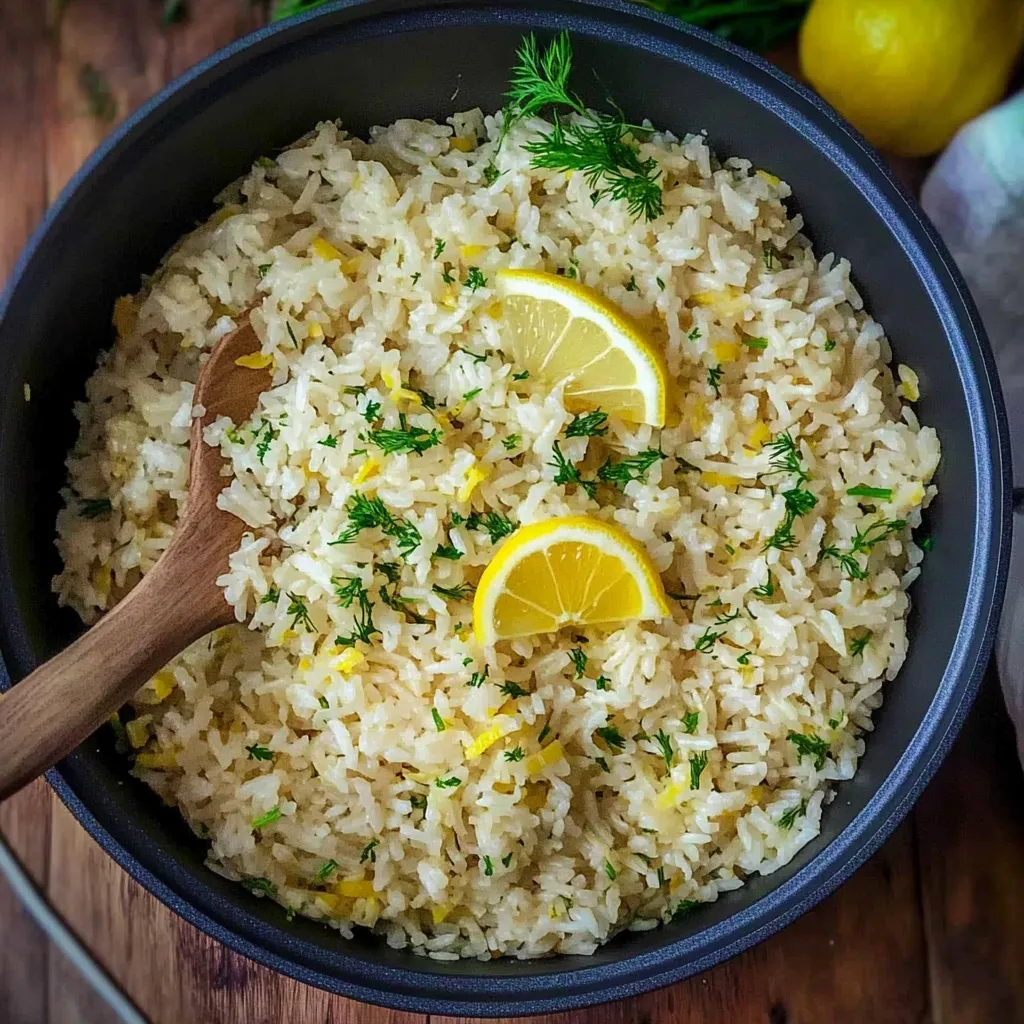 Pin it
Pin it
This vibrant Greek lemon rice (rizi lemonato) transforms ordinary rice into a fragrant, zesty side dish that steals the spotlight at any meal. The bright lemon flavor, aromatic herbs, and perfect texture create a dish that's both comforting and refreshing. Best of all, this one-pot wonder comes together in just 30 minutes, making it ideal for both weeknight dinners and special occasions.
I made this rice for a family gathering last month where my cousin, who typically avoids carbs, helped himself to seconds and thirds! My nephew, who normally pushes rice around his plate, actually asked if he could take the leftovers home. The bright lemon flavor and fluffy texture completely transforms ordinary rice into something extraordinary.
Ingredients:
- Long-grain white rice - The foundation of this dish, providing the perfect texture that allows each grain to remain separate and fluffy. Long-grain varieties absorb flavors beautifully while maintaining their structure, unlike stickier varieties like sushi or arborio rice.
- Extra virgin olive oil - Adds richness and authentic Mediterranean flavor. Greek olive oil, with its fruity, slightly peppery notes, enhances the dish's traditional character.
- Red onion - Offers a subtle sweetness that balances the bright lemon. When sautéed until translucent, it creates a flavorful foundation without overwhelming the delicate herbs.
- Fresh garlic - Provides aromatic depth that permeates each grain of rice. Fresh garlic is essential for that unmistakable flavor that dried garlic simply can't match.
- Chicken stock - Infuses the rice with savory richness as it absorbs during cooking. The concentrated flavor creates a much more complex dish than water ever could.
- Fresh lemon - Both the juice and zest are crucial for the signature bright, tangy flavor that defines this dish. Fresh lemons provide vibrant acidity and aromatic oils that bottled juice lacks.
- Fresh herbs - Parsley and dill add the distinctive Greek flavor profile, bringing freshness and color to the finished dish. Their bright notes complement the lemon perfectly.
- Salt and pepper - These simple seasonings enhance all the other flavors, bringing everything into perfect balance.
Instructions:
- Begin with proper rice preparation by placing 2 cups of long-grain white rice in a bowl and covering it with cool water. Let it soak for 20-30 minutes—this crucial step removes excess starch, ensuring your rice will be fluffy rather than sticky. After soaking, thoroughly rinse the rice in a fine-mesh colander until the water runs clear, then drain well. This washing process further removes starch and any impurities, creating the foundation for perfectly separated grains in your finished dish.
- Create your aromatic base by heating 3 tablespoons of extra virgin olive oil in a large, heavy-bottomed pot or deep skillet over medium heat. Once the oil shimmers, add one finely chopped red onion and 2-3 minced garlic cloves. Sauté gently for 3-4 minutes until the onion becomes translucent and the garlic is fragrant but not browned. This aromatic foundation will permeate every grain of rice, building layers of flavor from the very beginning.
- Toast the rice for enhanced flavor by adding your drained rice to the pot with the sautéed onions and garlic. Stir continuously for about 2-3 minutes until the rice becomes slightly translucent around the edges. This toasting step is essential—it opens up the grain's starch molecules, allowing them to absorb more flavor while cooking and prevents the rice from becoming mushy. The rice should make a gentle rustling sound as you stir, indicating it's drying out properly.
- Add liquid and bring to a proper boil by pouring in 4 cups of chicken stock and stirring once to ensure nothing sticks to the bottom of the pot. Allow the mixture to come to a full, vigorous boil—you should see bubbles breaking across the entire surface. The initial boil creates the steam needed for proper rice cooking. Once boiling, reduce the heat to the lowest possible setting, cover the pot with a tight-fitting lid, and set a timer for 15 minutes. Resist the urge to peek or stir during this cooking time, as removing the lid releases essential steam.
- Allow the rice to rest properly after the cooking time is complete. Without removing the lid, take the pot off the heat and let it stand, still covered, for 5 minutes. This resting period allows the rice to finish absorbing any remaining liquid and helps the grains firm up slightly. Then, remove the lid, place a clean kitchen towel over the pot, and replace the lid. The towel will absorb excess steam that would otherwise condense and fall back onto the rice, making it soggy. Let it rest with the towel for an additional 5 minutes.
- Finish with fresh flavors by removing the towel and lid and gently fluffing the rice with a fork—never stir with a spoon, which can crush the grains. Now add the zest of one lemon, 3 tablespoons of freshly squeezed lemon juice, 3 tablespoons of finely chopped fresh parsley, and 2 tablespoons of chopped fresh dill. Season with salt and freshly ground black pepper to taste. Fold these ingredients in gently using a fork or a wide spatula with a lifting motion rather than stirring, to maintain the rice's fluffy texture. The heat of the rice will release the essential oils in the lemon zest and wilt the herbs just enough to meld the flavors perfectly.
- Serve with intention by transferring the rice to a wide serving bowl rather than a deep dish, which can compress the bottom layers. Garnish with additional fresh herbs and lemon wedges for both visual appeal and to allow guests to add extra lemon if desired. The presentation should showcase the vibrant colors of the herbs distributed throughout the fluffy, pale yellow rice.
 Pin it
Pin it
I discovered that adding the lemon zest at the very end, rather than cooking it with the rice, preserves its bright, aromatic oils that would otherwise dissipate with heat. My Greek neighbor taught me this trick, explaining that her grandmother always said, "The nose should enjoy the meal first!" The fragrance when you lift the lid is absolutely intoxicating.
Perfect Rice Selection
The type of rice you choose dramatically affects the final dish. Long-grain white rice is traditional for this recipe because each grain contains less starch than medium or short-grain varieties, allowing the grains to remain separate after cooking. Basmati rice makes an excellent substitute with its naturally aromatic quality, though the flavor profile will shift slightly toward Indian cuisine. Jasmine rice works well too, adding a subtle floral note. Avoid arborio, sushi, or other sticky rice varieties that would create a texture more like risotto than the fluffy, separated grains this dish requires. Brown rice can be used for a nuttier, more nutritious version, but you'll need to adjust cooking time (usually to about 35-40 minutes) and liquid (about 1/4 cup more).
The Art of Fluffy Rice
Achieving perfectly fluffy rice with separated grains is both science and art. Beyond proper soaking and rinsing, the rice-to-liquid ratio is critical—too much liquid creates mushy rice, while too little leaves it undercooked and crunchy. The standard ratio for this recipe is 1 part rice to 2 parts liquid, but factors like pot size, lid tightness, and even altitude can affect this. If you're cooking at high altitude, you may need slightly more liquid and a longer cooking time. Another key factor is allowing the rice to rest after cooking, which gives the starches time to set and the grains to firm up. The kitchen towel technique is particularly valuable in humid environments where condensation can easily make rice soggy.
Seasonal Variations
While the classic version of Greek lemon rice uses parsley and dill, you can adapt this dish throughout the year using seasonal herbs. In spring, tender young mint leaves add brightness. Summer calls for fresh basil or oregano from the garden. Fall can welcome warming touches like a pinch of cinnamon or a few threads of saffron added to the broth. Winter versions benefit from heartier herbs like rosemary or thyme, though use these more sparingly as they're more potent. I've found that making seasonal adjustments keeps this dish in our regular rotation year-round without family members ever tiring of it.
I learned to make this rice years ago from my friend's grandmother, who emigrated from a small coastal town near Athens. She insisted on making it in a specific well-seasoned pot that had been in her family for generations. When I asked about measuring the ingredients, she laughed and said, "The pot knows the recipe!" While I've written down precise measurements here, there's truth to her wisdom—once you make this dish a few times, you'll develop an intuitive feel for it. The fragrance of lemon and herbs that fills your kitchen while preparing this dish is almost as rewarding as the first perfect forkful.
Frequently Asked Questions
- → Can I use brown rice instead?
- Yes, you can use brown rice but you'll need to adjust cooking time (about 35-40 minutes) and possibly add more liquid. The texture and flavor will be different.
- → Why do I need to soak the rice?
- Soaking removes excess starch, preventing stickiness and reducing cooking time. It helps create fluffy rice with separate grains.
- → Can I make this vegan?
- Absolutely! Just substitute vegetable stock for chicken stock, and you'll have a delicious vegan version.
- → How long does leftover lemon rice keep?
- Store leftovers in an airtight container in the refrigerator for up to 3-4 days. Reheat with a splash of water to restore moisture.
- → What dishes pair well with Greek lemon rice?
- Greek lemon rice pairs perfectly with grilled chicken, lamb, fish, or vegetable skewers. It also works well with Greek salad or roasted vegetables.
